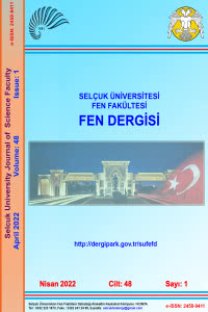PURIFICATION PHASES OF ZINC SULPHATE SOLUTION OBTAINED FROM NEUTRAL LEACHING PROCESS OF ZINC CALCINE
___
Boyanov, S.B., Victoria, V.K., Nikolai, K.K., 2004, “Purification of zinc sulfate solutions from cobalt and nickel through activated cementation”, Hydrometallurgy 73, 163–168.Dreher T.M., Nelson A., Demopoulos G.P., Filippou D., 2001, “The Kinetics of Cobalt Removal by Cementation from an Industrial Zinc Electrolyte in the Presence of Cu, Cd, Pb, Sb and Sn Additives” Hydrometallurgy, 60, pp. 105-116,
Friedrich Berndt., Kruger Joachim, Mendez Bernal Graciella ,2002 “ Alternative solution purification in the hydrometallurgical zinc production”, Savez Inzenjera metalurgije Jugoslavije
Free M, lebrary (e-book collection).2013 Hydrometallurgy: fundamentals and applications. Hoboken, N.J: TMS-Wiley;
Fosnachtet, D. R., O’Keefe T. J., 1983, “The effects of certain impurities and their interactions on zinc electrowinning”, Metallurgy Transactions, 14, 645-655
Fugleberg S., 2014, “Improving the competitiveness of the electrolytic zinc process by chemical reaction engineering approach” Laboratory of Industrial Chemistry and Reaction Engineering,
Ha M K, et.al., Kumar V, Singh R J,2001 “ Review of hydrometallurgical recovery of zinc from industrial wastes “, Resources Conservation and Recycling, 2001, 33(1): 1−22
Han J., Liu W., Qin W., Zheng Y., and Luo H., 2016, “Optimization Study on the Leaching of High IronBearing Zinc Calcine After Reduction Roasting,” Metallurgical andMaterials Transactions B: Process Metallurgy and Materials Processing Science, vol. 47, no. 1, pp. 686–693,
Karoleva V., “Metallurgy of non-ferrous metals”, V.2, Technika, Sofia, 1986 (in Bulgarian)
Kazanbaev L.A., Kozlov P.A., Kubasov V.L., Kolesnikov A.V., 2006 “Zinc Hydrometallurgy”, Ore and Metals, p. 176
Lew R. W.,1994. “The removal of cobalt from zinc sulphate electrolytes using copper-antimony process” Vol. British columbia, Vancouver, Canada,
Li Mi, Peng Bing, Chai Li-yuan, Peng Ning, Yan Huan, Hou Dong-ke, 2012 “ Recovery of iron from zinc leaching residue by selective reduction roasting with carbon “, Journal of Hazardous Materials, 2012, 237−238: 323−330
Moghaddam J., Sarraf-Mamoory R., Abdollahy M., Yamini Y.,2006 “Purification of zinc ammoniacal leaching solution by cementation: Determination of optimum process conditions with experimental design by Taguchi’s method” , Separation and Purification Technology, 51, 157-164
Muresan L., Maurin G., Oniciu L. and Gaga D., Hydrometallurgy, 43 (1996) 345.
Näsi J., 2007 “ Intensified use of process measurements in hydrometallurgical zinc production processes”Faculty of Technology of the University of Oulu
Nelson A., Demopoulos G.P. and Houlachi G., 2000 “The effect of solution constituents and novel activators on cobalt cementation”, Canadian Metallurgical Quarterly, Vol 39, No 2, pp. 175- 186.Process Chemistry Centre .Department of Chemical Engineering, Åbo Akademi University Turku/Åbo Finland
Nyman B., Aaltonen A., Hultholm S. E., K. Karpale,1992 “ Application of new hydrometallurgical develop-ments in the Outokumpu HIKO process”, Hydrometallurgy, 29(1992), 461-478
Pietrzyk S., Palimąka P., Stępień M., Krawczykowska A., Tora B., Fatyga M., Pajor G., and Mańka A., 2017 “Silver recovery from zinc metallurgical sludge – analysis of solutions” E3S Web of Conferences 18 , 01027 MEC2017
Purification Process, Vieille Montagne, 1982 Operating Guide, Book III, Trepca mine, zinc plant, 1982, Mitrovica, Kosovo
Ru, Zhen-guang, Pan Cen-xuan, Liu Gui-hua, Wang Xue-ting, Dou Guang-yu, Zhu Ke-song, 2015 “Leaching and recovery of zinc from “ Leaching residue of zinc calcine based on membrane filter press” Trans. Nonferrous Met. Soc. China 25, 622−627
Sethurajan M., Huguenot D., R. Jain et al., 2017“Leaching and selective zinc recovery from acidic leachates of zinc metallurgical leach residues”, Journal of Hazardous Materials, vol. 324, pp. 71– 82,
Svens K.,2012 “Direct leaching alternatives for zinc concentrates”,T.T. Chen Honorary Symposium on Hydrometallurgy, Electrometallurgy and Materials Characterization, TMS (The Minerals, Metals & Materials Society)
Turan M. Deniz, Altundogan H. Soner, Tumen Fikret, 2004 “Recovery of zinc and lead from zinc plant residue”, Hydrometallurgy 75 (2004) 169–176,
Van Der Pas V., Dreisinger D. B., 1996 “A fundamental study of cobalt cementation by zinc dust in the presence of copper and antimony additives”, Hydrometallurgy, 43, 187-205
- ISSN: 2147-9364
- Yayın Aralığı: Yılda 2 Sayı
- Başlangıç: 2013
- Yayıncı: Selçuk Üniversitesi Mühendislik Fakültesi
Mümüne SERT, Saadettin Erhan KESEN
EFFECT OF ASPECT RATIO ON THE FREEZING-THAWING OF A CH CLAY
R. Kağan AKBULUT, A. Şahin ZAİMOĞLU
Yaşlandırma Süresinin Co-Cr-Mo Alaşımlarının Faz Dönüşümleri, Mikroyapıları ve Sertliğine Etkisi
KOBALT KATKILI ÇİNKO OKSİT NANOPARÇACIKLARIN YAPISAL ÖZELLİKLERİNİN İNCELENMESİ
Güvenç AKGÜL, Funda AKSOY AKGÜL
BİLGİSAYARLI GÖRÜ SİSTEMLERİ İÇİN SİSTEM TASARIMI VE KONTROLÜ
Birkan BÜYÜKARIKAN, İsmail Serkan ÜNCÜ
APPROXIMATE DYNAMIC PROGRAMMING FOR OPTIMAL SEARCH WITH AN OBSTACLE
DELME HIZI VE BASKI KUVVETİNİN ENERJİ TÜKETİMİNE ETKİSİNİN ARAŞTIRILMASI
EFFECT OF AGING TIME ON PHASE TRANSFORMATION, MICROSTRUCTURE AND HARDNESS OF Co-Cr-Mo ALLOYS
Ali KELEŞ, Mehmet Serdar YILDIRIM
MEME KANSERİ TANISI İÇİN DERİN ÖZNİTELİK TABANLI KARAR DESTEK SİSTEMİ
